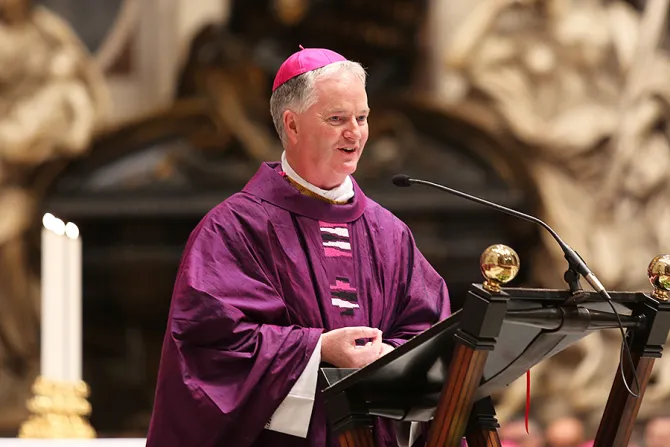Vatican City, Mar 21, 2018 / 12:17 pm
A new chapter for Vatican media and communications began Apr. 30, 2015, when Pope Francis established a commission of five members to analyze and implement the suggestions of a report from a Vatican Committee for Communication, which itself had been established in July 2014.
The commission, whose establishment was seen by some as a rejection of the previous committee, was chaired by Msgr. Dario Edoardo Viganò, who at the time was still director of Vatican Television. The members were Msgr. Lucio Adrian Ruiz, Fr. Antonio Spadaro, the editor of the Jesuit magazine La Civiltà Cattolica, and then-Msgr. Paul Tighe, who was Secretary of the Pontifical Council for the Social Communication, and Paolo Nusiner, who came from the board of the Italian episcopal conference newspaper Avvenire.
Msgr. Tighe was – along with Msgr. Ruiz – the only member of the original committee chaired by Lord Christopher Patten, which had drafted a reform proposal after a series of meetings with the staff of the Vatican media departments.
Then, the story is well known: Msgr. Tighe was promoted adjunct secretary of the Pontifical Council of Culture and ordained a bishop, Msgr. Ruiz became second-in-command at the Secretariat for Communications, while Msgr. Dario Edoardo Viganò was appointed prefect.
This morning, Vigano's resignation as prefect was accepted; he will now serve as a consultor to the secretariat.
In this moment of crisis, many eyes are nowfixed on Bishop Tighe.
Vatican observers note that Tighe was received in a private audience by Pope Francis March 15, two days after the "Vatican lettergate" – as it was eventually dubbed – had exploded. Other Vatican insiders told CNA that Bishop Tighe is scheduled for another meeting with Pope Francis March 26.
Are these clues that Bishop Tighe will become the dicastery's prefect?
On the plus side, he has been a part of the reform project since the beginning, he understands the adjustments that have been made, and he is a bishop, which gives him a status Msgr. Viganò did not have.
On the other hand, should he be called to carry on a reform that he helped to design, he will be called to ride very difficult waves.
Msgr. Viganò used to say that every reform faces resistance. In the case of the Vatican media reform, it seemed there was something more. Sources told CNA that the first leak about the doctoring of Benedict XVI's letter came from inside the Secretariat for the Communication- this could be a sign of real internal discord.
From the time a commission was established to analyze and carry on the Patten Report, it was already clear that an internal struggle might take place: the commission had no representatives of Vatican Radio, the Vatican media department most touched by the reform. And neither were the Holy See Press Office, L'Osservatore Romano and the Vatican Publishing House represented. It is noteworthy that Gian Maria Vian, editor of L'Osservatore Romano, was a member of the Lord Patten committee, but not the subsequent commission.
The reform was carried forward, and led to the launch of the new Vatican News website, along with the Vatican media department that absorbed audio/video responsibilities previously entrusted to the L'Osservatore Romano Photo Service and to Vatican Television, while Vatican Radio ceased its legal existence and was absorbed in the Vatican News department, with a special label for Italian broadcasting called Radio Vaticana Italia.
In 2015, the motu proprio L'attuale contesto comunicativo established the Secretariat for Communication, and on Sep. 22, 2016 the statues of the new secretariat were finally published.
The statutes divided the Secretariat for Communication into five 'directions,' or departments: the general affairs department; the editorial direction; the technological direction; the pastoral-theological direction; and the direction of the Holy See Press Office.
The five directions were part of the Lord Patten proposal, as he explained in a lecture delivered May 28, 2015.
However, internal discussion about how to carry out the reform was open-ended.
Since the first Vatileaks scandal, back in 2012, discussion about communications issues have been intense within the Vatican. During the Vatileaks scandal, the Vatican decided to hire an advisor for communications within the Secretariat of State, American Greg Burke.
Communication strategy was important to cardinals during meeting preceding the conclave that elected Pope Francis.
This is the reason why cardinals in conclave chose for a "change of narrative," according to a Wall Street Journal report based on conversation with four different cardinals. When Pope Francis' started his reform plan, global consulting firm McKinsey & Company was engaged to propose a new Vatican media strategy.
But the discussion was not just technical. It also entailed the philosophy behind the Vatican's communication strategy, and on that front, many questions remain unanswered.
Angelo Scelzo, a long term Vatican official who ended his career as deputy Director of the Holy See's Press Office, and for years was an official of the Pontifical Council for Social Communications, explained well the issues at stake.
In 2014, Scelzo wrote a book tracing back 50 years of Vatican communications, starting with the Second Vatican Council's Inter Mirifica, its decree on social communications.



